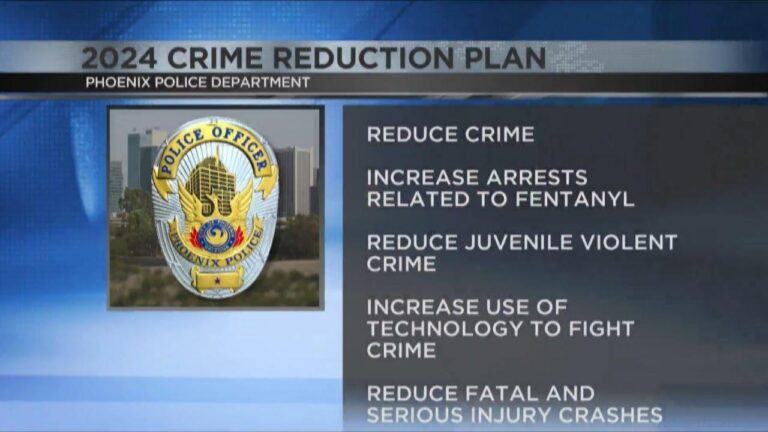Phoenix’s recent crime prevention initiatives have yielded promising results in targeted neighborhoods, city officials reported this week. While statistics indicate a decline in criminal activity in these key areas, leaders emphasize that continued efforts and expanded strategies are essential to sustaining and broadening the progress. As Phoenix faces ongoing public safety challenges, officials are urging the community and stakeholders to remain engaged in the multi-faceted approach aimed at creating safer streets citywide.
Phoenix Crime Prevention Initiatives Yield Positive Results in Key Neighborhoods
Recent efforts by Phoenix authorities focused on crime prevention have demonstrated promising outcomes in neighborhoods previously identified as high-risk. Targeted community policing, increased lighting in public spaces, and collaborative programs involving local nonprofits have contributed to tangible reductions in property crimes and violent incidents. Notably, neighborhoods such as Maryvale, South Mountain, and Central City have seen a 15% decrease in reported crimes over the past year, according to data released by the Phoenix Police Department.
City leaders emphasize, however, that these gains represent only initial progress and advocate for sustained investment in preventative measures. Key initiatives currently under evaluation include:
- Enhanced youth outreach programs targeting at-risk populations
- Expansion of surveillance technology in public areas
- Community-driven neighborhood watch groups
- Increased mental health resources integrated with law enforcement
The following table highlights key crime statistics comparing 2023 with 2022 across selected neighborhoods:
| Neighborhood | 2022 Crimes Reported | 2023 Crimes Reported | % Change |
|---|---|---|---|
| Maryvale | 1,200 | 1,020 | -15% |
| South Mountain | 850 | 720 | -15.3% |
| Central City | 1,100 | 935 | -15% |
City Officials Emphasize Need for Expanded Resources and Community Engagement
City leaders acknowledge recent gains in curbing crime within specific neighborhoods but stress that current achievements are just the beginning. Officials advocate for an increase in funding directed toward community outreach initiatives and enhanced public safety programs. Emphasizing collaboration, they highlight the importance of integrating social services, educational programs, and neighborhood watch efforts to sustain and build upon existing momentum.
Key components identified by city officials to advance these goals include:
- Expanded mental health resources accessible to vulnerable populations
- Strengthened partnerships between law enforcement and local organizations
- Community-based engagement to foster trust and accountability
- Investment in youth programs aimed at prevention and education
| Resource | Current Allocation | Requested Increase |
|---|---|---|
| Mental Health Services | $1.2M | $500K |
| Community Outreach | $900K | $400K |
| Youth Programs | $750K | $350K |
| Neighborhood Policing | $1.5M | $600K |
Data Highlights Persistent Challenges Despite Targeted Successes
While recent statistics show a decline in specific crime categories like property theft and gang-related violence in several Phoenix neighborhoods, the overall picture remains mixed. Certain districts have experienced marked progress due to focused policing strategies and community engagement initiatives. However, other areas continue to grapple with stubborn rates of violent crime and drug-related offenses, highlighting the uneven impact of prevention efforts across the city.
City officials emphasize that success in target zones does not equate to a universal solution. Continuing challenges include:
- Limited resources stretched thin across sprawling urban areas
- Persistent socio-economic disparities contributing to entrenched crime patterns
- Coordination gaps between local law enforcement and social services
| Neighborhood | Crime Rate Change (%) | Focus Area |
|---|---|---|
| South Phoenix | -15% | Property Crime |
| Downtown | -10% | Gang Violence |
| West Valley | +8% | Drug Offenses |
| East Phoenix | +3% | Violent Crime |
Experts Recommend Comprehensive Strategy to Sustain and Broaden Impact
Specialists in urban safety emphasize that while targeted efforts in Phoenix have yielded noticeable declines in specific crime rates, a multidimensional approach is essential to maintain momentum and extend benefits citywide. Authorities should integrate community engagement, technology advancements, and socioeconomic initiatives to address the root causes of crime and ensure sustainable improvements. Among key recommendations are:
- Expanding community programs to foster trust and cooperation between residents and law enforcement.
- Investing in predictive analytics and smart surveillance tools to anticipate and prevent criminal activity.
- Enhancing social services that focus on education, employment, and mental health support to reduce recidivism.
Furthermore, experts stress the importance of data-driven monitoring and transparent reporting to continuously adapt strategies based on measurable outcomes. The following table illustrates key performance indicators (KPIs) recommended for ongoing assessment:
| KPI | Target Metric | Measurement Frequency |
|---|---|---|
| Violent Crime Reduction | 10% annual decrease | Monthly |
| Community Engagement Events | Quarterly increase by 15% | Quarterly |
| Recidivism Rate | Reduce to under 25% | Biannual |
To Wrap It Up
As Phoenix continues to build on the progress seen in its targeted crime prevention initiatives, city leaders emphasize that sustained commitment and expanded efforts will be essential to address ongoing challenges citywide. While early successes offer a promising framework, officials acknowledge that collaboration with community stakeholders and investment in resources remain critical to ensuring long-term public safety improvements across all neighborhoods. The coming months will be pivotal as Phoenix evaluates these programs and explores additional strategies to create a safer environment for all residents.







